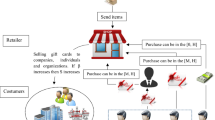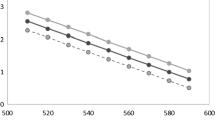Abstract
We develop a model of free gift card promotions in a two-product supply chain. We analyze three cases with different gift card strategies based on whether the wholesale and retail prices are changed or unchanged. The results indicate that, in the strategy of unchanged wholesale and retail prices, the retailer and two manufacturers are better off. The gift card promotions can effectively stimulate the demands of two products. We find that the two manufacturers benefit more from the gift card promotion than the retailer does. In the strategy of unchanged wholesale prices and changed retail prices, if the gift card value is not very large, the retailer’s profit margins and average consumer surplus from the gift card promotion are increasing in the gift card value. In the strategy of changed wholesale and retail prices, the retailer and two manufacturers have an incentive to raise the retail and wholesale prices under certain conditions. Furthermore, we show that, keeping the prices at the level of no gift cards is the dominant strategy for the supply chain and consumers, and the difference between retail prices and wholesale prices of two products is the key factor in determining the gift card value.






Similar content being viewed by others
References
Anderson ET, Song I (2004) Coordinating price reductions and coupon events. J Mark Res 41(4):411–422
Andrews M, Luo X, Fang Z, Aspara J (2014) Cause marketing effectiveness and the moderating role of price discounts. J Mark 78(6):120–142
Aviv Y, Pazgal A (2008) Optimal pricing of seasonal products in the presence of forward-looking consumers. Manuf Serv Oper Manag 10(3):339–359
Besanko D, Winston WL (1990) Optimal price skimming by a monopolist facing rational consumers. Manag Sci 36(5):555–567
Bhargava HK (2013) Mixed bundling of two independently valued goods. Manag Sci 59(9):2170–2185
Cai GG (2010) Channel selection and coordination in dual-channel supply chains. J Retail 86(1):22–36
Chao Y, Derdenger T (2013) Mixed bundling in two-sided markets in the presence of installed base effects. Manag Sci 59(8):1904–1926
Chen Y, Moorthy S, Zhang ZJ (2005) Price discrimination after the purchase: a note on rebates as state-dependent discounts. Manag Sci 51(7):1131–1140
Chew EP, Lee LH, Wang Q (2015) Mixed bundle retailing under a stochastic market. Flex Serv Manuf J 27(4):606–629
Consumer Reports (2014) Target gives you 50 reasons to get an Apple iPad. Retrieved October 20, 2016. http://www.consumerreports.org/cro/news/2014/08/target-gives-you-50-reasons-to-get-an-apple-ipad/index.htm
Dhar SK, Morrison DG, Raju JS (1996) The effect of package coupons on brand choice: an epilogue on profits. Mark Sci 15(2):192–203
Ernez-Gahbiche I, Hadjyoussef K, Dogui A, Jemai Z (2019) Decentralized versus cooperative performances in a Nash game between a customer and two suppliers. Flex Serv Manuf J 31(2):279–307
Geng Q, Mallik S (2011) Joint mail in rebate decisions in supply chains under demand uncertainty. Prod Oper Manag 20(4):587–602
Helion C, Gilovich T (2014) Gift cards and mental accounting: green lighting hedonic spending. J Behav Dec Mak 27(4):386–393
Horne DR (2007a) Gift cards: disclosure one step removed. J Consum Affairs 41(2):341–345
Horne DR (2007b) Unredeemed gift cards and the problem of not providing customers with value. J Consum Mark 24(4):192–193
Horne DR (2013) Patterns of gift card non-redemption. Consum Interests Annu 59:1–5
Horne DR, Bendle N (2016) Gift cards: a review and research agenda. Int Rev Retail Distrib Consum Res 26(2):154–170
Khouja M, Pan J, Brian TR, Zhou J (2011) Analysis of free gift card program effectiveness. J Retail 87(4):444–461
Khouja M, Pan J, Zhou J (2016) Effects of gift cards on optimal order and discount of seasonal products. Eur J Oper Res 248(1):159–173
Khouja M, Park S, Zhou J (2013a) A free gift card alternative to price discounts in the newsvendor problem. Omega 41(4):665–678
Khouja M, Rajagopalan HK, Zhou J (2013b) Analysis of the effectiveness of manufacturer sponsored retailer gift cards in supply chains. Eur J Oper Res 230(2):333–347
Khouja M, Zhou J (2015) Channel and pricing decisions in a supply chain with advance selling of gift cards. Eur J Oper Res 244(2):471–489
Li Y, Pan J, Tang X (2021) Optimal strategy and cost sharing of free gift cards in a retailer power supply chain. Int Trans Oper Res 28(2):1018–1045
Lu Q, Moorthy S (2007) Coupons versus rebates. Mark Sci 26(1):67–82
Mandel N, Scott ML, Kim S, Sinha RK (2017) Strategies for improving self-control among naïve, sophisticated, and time-consistent consumers. J Econ Psychol 60:109–125
Mussa M, Rosen S (1978) Monopoly and product quality. J Econ Theory 18(2):301–317
Narasimhan C (1984) A price discrimination theory of coupons. Mark Sci 3(2):128–147
Neslin SA, Shoemaker RW (1983) A model for evaluating the profitability of coupon promotions. Mark Sci 2(4):361–380
Norvell T, Horky A (2017) Gift card program incrementality and cannibalization: the effect on revenue and profit. J Retail Consum Serv 39:250–257
Prasad A, Venkatesh R, Mahajan V (2010) Optimal bundling of technological products with network externality. Manag Sci 56(12):2224–2236
Rubin AP, Benton WC (2003) A generalized framework for quantity discount pricing schedules. Dec Sci 34(1):173–188
Soman D (1998) The illusion of delayed incentives: evaluating future effort-money transaction. J Mark Res 35(4):427–437
Stokey NL (1979) Intertemporal price discrimination. Q J Econ 93(3):355–371
Waldfogel J (1993) The deadweight loss of Christmas. Am Econ Rev 83(5):1328
Waldfogel J (2009) Scroogenomics: why you shouldn’t buy presents for the holidays. Princeton University Press, Princeton
Weng ZK (1995) Channel coordination and quantity discounts. Manag Sci 41(9):1509–1522
Wolf A (2007) The gift that keeps on giving. Consum Electron 22:85
Yao Q, Chen R (2014) Gift cards and gifted cash: the impact of fit between gift type and message construal. J Retail 90(4):481–492
Zhang Q, Zhang D, Segerstedt A, Luo J (2018) Optimal ordering and pricing decisions for a company issuing product-specific gift cards. Omega 74:92–102
Acknowledgements
The authors are extremely grateful to the anonymous reviewers and the Department Editor for their constructive comments and suggestions, which have greatly improved the exposition of this paper. This work was supported by the National Natural Science Foundation of China (Grant Nos. 71531003 and 71272127) and the China Scholarship Council (Grant No. 201806070094).
Author information
Authors and Affiliations
Corresponding author
Additional information
Publisher's Note
Springer Nature remains neutral with regard to jurisdictional claims in published maps and institutional affiliations.
Appendix
Appendix
Proof
Proposition 1
Substituting Eqs. (1) and (2) into Eq. (4), we have
Taking the first and second derivations of \(\pi _r^{NG}(p_1,p_2)\), we have
Then, the Hessian matrix is
Since \(|H_1|=-\frac{2n}{a_1}<0\) and \(|H_2|=\frac{4n^2}{a_1a_2}>0\), then \(\pi _r^{NG}\) is jointly concave in \(p_1\) and \(p_2\). From the first-order-condition, the optimal retailer prices are given by \(p_1^*(w_1)=\frac{a_1+w_1}{2}\) and \(p_2^*(w_2)=\frac{a_2+w_2}{2}\).
Substituting Eq. (1) and \(p_1^*(w_1)\) into Eq. (5), we have
Taking the first and second derivations of \(\pi _{m1}^{NG}(w_1)\) , we have \(\frac{\partial \pi _{m1}^{NG}(w_1)}{\partial w_1}=\frac{n(a_1-2w_1)}{2a_1}\) and \(\frac{\partial ^2 \pi _{m1}^{NG}(w_1)}{\partial w_1^2}=-\frac{n}{a_1}\). Since \(\frac{\partial ^2 \pi _{m1}^{NG}(w_1)}{\partial w_1^2}<0\), then \(\pi _{m1}^{NG}(w_1)\) is concave in \(w_1\). From \(\frac{\partial \pi _{m1}^{NG}(w_1)}{\partial w_1}=0\), we get the optimal wholesale price of product 1 \(w_1^{NG*}=a_1/2\). Then, we get the optimal retail price of product 1 \(p_1^{NG*}=3a_1/4\).
Substituting Eq. (2) and \(p_2^*(w_2)\) into Eq. (6), we have
Taking the first and second derivations of \(\pi _{m2}^{NG}(w_2)\) , we have \(\frac{\partial \pi _{m2}^{NG}(w_2)}{\partial w_2}=\frac{n(a_2-2w_2)}{2a_2}\) and \(\frac{\partial ^2 \pi _{m2}^{NG}(w_2)}{\partial w_2^2}=-\frac{n}{a_2}\). Since \(\frac{\partial ^2 \pi _{m2}^{NG}(w_2)}{\partial w_2^2}<0\), then \(\pi _{m2}^{NG}(w_2)\) is concave in \(w_2\). From \(\frac{\partial \pi _{m2}^{NG}(w_2)}{\partial w_2}=0\), we get the optimal wholesale price of product 2 \(w_2^{NG*}=a_2/2\). Then, we get the optimal retail price of product 2 \(p_2^{NG*}=3a_2/4\). \(\square\)
Proof
Proposition 2
Substituting \(w_1=a_1/2\), \(w_2=a_2/2\), \(p_1=3a_1/4\) and \(p_2=3a_3/4\) into Eq. (10), we have
Taking the first and second derivations of \(\pi _r^{GUWP}\), we have \(\frac{\partial \pi _r^{GUWP}}{\partial g}=\frac{n[a_1a_2-4(a_1+a_2)rg-24r^2g^2]}{16a_1a_2}\) and \(\frac{\partial ^2 \pi _r^{GUWP}}{\partial g^2}=-\frac{n(a_1+a_2+12rg)}{4a_1a_2}\). Since \(\frac{\partial ^2 \pi _r^{GUWP}}{\partial g^2}<0\), then \(\pi _r^{GUWP}\) is concave in \(g\). From \(\frac{\partial \pi _r^{GUWP}}{\partial g}=0\), we get the optimal gift card value \(g^{GUWP^*}=\frac{\sqrt{a_1^2+8a_1a_2+a_2^2}-(a_1+a_2)}{12r}\). \(\square\)
Proof
Corollary 1
According to Proposition 2, we have
\(\square\)
Proof
Proposition 3
From Tables 1 and 4, we can get the results of this Proposition. \(\square\)
Proof
Proposition 4
Substituting \(w_1=a_1/2\) and \(w_2=a_2/2\) into Eq. (10), we have
Taking the first and second derivations of \(\pi _r^{GUW}\) , we have
Then the Hessian matrix is
We have \(|H_1|=-2n/a_1<0\) and \(|H_2|=\frac{n^2(4a_1a_2-9r^2g^2)}{a_1^2a_2^2}\). Since \(0<g<a_i/2(i=1,2)\), then \(|H_2|>0\). So \(\pi _r^{GUW}\) is jointly concave in \(p_1\) and \(p_2\). From the first-order-condition, we get the optimal retailer prices. \(\square\)
Proof
Corollary 2
According to Proposition 4, we have
\(\square\)
Proof
According to the proof of Proposition 4, we know that given a gift card value \(g\), when \(a_1=a_2=a\), the optimal solutions of \(p_1^*\) and \(p_2^*\) are determined by the two first-order conditions
From Eqs. (17) and (18), we get \(p_1^*=p_2^*=\frac{3 a^2+5 a G+3 r^2g^2}{2 (2 a+3 rg)}\). Substituting them into Eq. (17), we have
Taking the first and second derivations of \(\pi _r^{GUW}(p_1^*,p_2^*)\), we have
and
Since \(0<g\le a/2\), then \(0<rg\le a/2\). If \(a/7\le rg\le a/2\), then \(\frac{\partial \pi _r^{GUW}(p_1^*,p_2^*)}{\partial g}<0\). So, \(\pi _r^{GUW}(p_1^*,p_2^*)\) is decreasing in \(g\) and the optimal gift card value \(G^*=\frac{a}{7r}\). if \(0<rg\le a/7\), then \(\frac{\partial ^2 \pi _r^{GUW}(p_1^*,p_2^*)}{\partial g^2}<0\). So, \(\pi _r^{GUW}(p_1^*,p_2^*)\) is concave in \(g\) and the optimal gift card value \(g^*\) is determined by the first-order condition \(\frac{\partial \pi _r^{GUW}(p_1^*,p_2^*)}{\partial g}=0\). Thus, when \(0<g\le a/2\), the optimal gift card value satisfies \(g^*<\frac{a}{7r}\). \(\square\)
Proof
Proposition 6
Substituting Eqs. (7), (8) and (9) into Eq. (10), we have
Taking the first and second derivations of \(\pi _r^{DG}\) , we have
Then the Hessian matrix is
We have \(|H_1|=-\frac{2n}{a_1}<0\) and \(|H_2|=\frac{n^2(4a_1a_2-9r^2g^2)}{a_1^2a_2^2}\). Since \(0<g\le \frac{a_i}{2}(i=1,2)\), then \(|H_2|>0\). So \(\pi _r^{DG}\) is jointly concave in \(p_1\) and \(p_2\). From \(\frac{\partial \pi _r^{DG}}{\partial p_1}=0\) and \(\frac{\partial \pi _r^{DG}}{\partial p_2}=0\), the optimal retailer prices are given by
and
Substituting \(p_1^*(w_1,w_2)\) and \(p_2^*(w_1,w_2)\) into Eq. (11), we have
Taking the first and second derivations of \(\pi _{m1}^{DG}\) , we have
and
Since \(\frac{\partial ^2 \pi _{m1}^{DG}}{\partial w_1^2}<0\), then \(\pi _{m1}^{DG}\) is concave in \(w_1\) and the optimal wholesale price of product 1 is determined by the first-order-condition.
Substituting \(p_1^*(w_1,w_2)\) and \(p_2^*(w_1,w_2)\) into Eq. (12), we have
Taking the first and second derivations of \(\pi _{m2}^{DG}\) , we have
and
Since \(\frac{\partial ^2 \pi _{m2}^{DG}}{\partial w_2^2}<0\), then \(\pi _{m2}^{DG}\) is concave in \(w_2\) and the optimal wholesale price of product 2 is determined by the first-order-condition. Solving \(\frac{\partial \pi _{m1}^{DG}}{\partial w_1}=0\) and \(\frac{\partial \pi _{m2}^{DG}}{\partial w_2}=0\), we can get the optimal wholesale prices of two products \(w_1^{DG^*}\) and \(w_2^{DG^*}\). Substituting \(w_1^{DG^*}\) and \(w_2^{DG^*}\) into\(p_1^*(w_1,w_2)\) and \(p_2^*(w_1,w_2)\), we get the optimal retail prices of two products \(p_1^{DG^*}\) and \(p_2^{DG^*}\). \(\square\)
Proof
Corollary 4
The proof of this Corollary is similar to that of Corollary 2. \(\square\)
Proof
Corollary 5
The proof of this Corollary is similar to that of Corollary 2. \(\square\)
Proof
Corollary 6
Let \(G=rg\). According to Proposition 6 and Proposition 1, we have
and
When \(a_1 \le a_2\), then \(w_1^{DG^*}-w_1^{NG^*}>0\). Let \(G_1^{DG}\) be the smallest positive real root of \(6 G^4-19 a_1 G^3+6 a_1a_2 G^2+9 a_1^2 a_2 G-4 a_1^2 a_2^2=0\). When \(a_1 > a_2\) and \(0<G<G_1^{DG}\), then \(w_1^{DG^*}-w_1^{NG^*}>0\); when \(a_1 > a_2\) and \(G_1^{DG}\le G<a_2/2\), then \(w_1^{DG^*}-w_1^{NG^*}<0\).
When \(a_1\ge a_2\), then \(w_2^{DG^*}-w_2^{NG^*}>0\). Let \(G_2^{DG}\) be the smallest positive real root of \(6 G^4-19 a_2 G^3+6 a_1a_2 G^2+9 a_1 a_2^2 G-4 a_1^2 a_2^2=0\). When \(a_1< a_2\) and \(0<G<G_2^{DG}\), then \(w_2^{DG^*}-w_2^{NG^*}>0\); when \(a_1<a_2\) and \(G_2^{DG} \le G<a_1/2\), then \(w_2^{DG^*}-w_2^{NG^*}<0\). \(\square\)
Rights and permissions
About this article
Cite this article
Li, Y., Pan, J. & Zhou, J. Optimal pricing with free gift cards in a two-product supply chain. Flex Serv Manuf J 34, 125–155 (2022). https://doi.org/10.1007/s10696-021-09409-8
Accepted:
Published:
Issue Date:
DOI: https://doi.org/10.1007/s10696-021-09409-8




